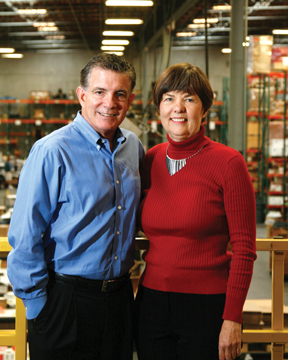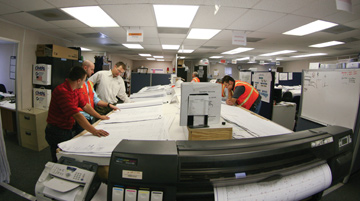Deciding to sell
How D&D Tool and Supply in southern California transitioned from acquirer to being acquired
 When Georgia Dutro started getting phone calls from potential suitors about acquiring her company in early 2010, she knew she had some serious decisions to make. As president of D&D Tool and Supply in Vista, Calif., Dutro was no stranger to acquisitions. Having acquired 15 distribution companies over the years, she understood the difficulty in blending different corporate cultures together.
When Georgia Dutro started getting phone calls from potential suitors about acquiring her company in early 2010, she knew she had some serious decisions to make. As president of D&D Tool and Supply in Vista, Calif., Dutro was no stranger to acquisitions. Having acquired 15 distribution companies over the years, she understood the difficulty in blending different corporate cultures together.
Through acquisitions and organic growth, the company's annual sales climbed to approximately $36 million by the end of 2008. The distributor of industrial, safety and tooling supplies had three locations in southern California and a facility in Tijuana, Mexico.
When the recession hit, it caused a dip in sales at the same time that customers were increasing pressure on suppliers to expand their product categories so customers could consolidate their supply base. In addition, Dutro also knew that she likely would have to invest in new technology, such as a radio frequency management system, to improve warehouse efficiency. Investing in products, technology and people would require capital.
So Dutro began to explore some of the acquisition offers. Before making a final decision, however, she sought advice from an old friend and mentor, Bob Zamarripa, president and founder of OneSource Distributors in nearby Oceanside, Calif. OneSource is a $335 million regional distributor of electrical, automation and utility equipment and supplies to the industrial, commercial, infrastructure, OEM and utility markets throughout California, Hawaii and parts of Arizona.
Dutro and Zamarripa met two decades ago at an event hosted by a common customer. Since they sold non-competing product categories, they'd get together over the ensuing years to discuss best practices and talk about changes taking place in distribution.
OneSource had completed multiple acquisitions – but on a larger scale than D&D – so the pair often shared thoughts about how to integrate acquired companies.
By the fall of 2010, when Dutro was considering an acquisition offer from a private equity firm, it was natural to mention it to her friend.
"If you're seriously thinking about selling your company, we need to talk," Zamarripa told her.
Although OneSource had previously acquired electrical distributors, Zamarripa was beginning to formulate a strategy to expand into new product categories. OneSource had slowly started adding safety supplies and other industrial products to its line card, but Zamarripa was also open to searching for a potential acquisition target. If Dutro's company was for sale, it might make a good fit.
The two organizations shared similar management philosophies, the same distribution software system and a few common customers, but each company also offered expertise the other lacked. OneSource has a highly efficient RF-enabled warehouse, information technology and logistics capabilities, and a broader geographic market; D&D offers an experienced and knowledgeable industrial supply sales team with strong customer service skills, and provides custom tool sharpening and other customer-specific services. Dutro invited Zamarripa to make a purchase offer.
 The deal is done
The deal is done
It didn't take long for the two to come to terms on an all-cash purchase offer that would enable Dutro, her management team and most customer-facing employees to remain. By early January 2011, the due diligence process was completed and final purchase documents were signed.
Within 30 days after the sale closed, all data from D&D's ERP system was converted to the Eclipse software version used by OneSource. By day 60, all inventory from D&D's 50,000-square-foot warehouse was transferred to the OneSource main warehouse. Within two months of the sale of her company, Dutro had already achieved efficiencies that would have taken several months, if not years, and thousands of dollars to implement.
"A lot of small distributors are in a position like we were in," she says. "They need to make major investments in things like IT and RF warehouses. I also wanted to automate my whole CRM process and have it integrate with my operating system. These are huge investments in dollars and time. With OneSource, all of those things are already in place."
She added that joining forces with OneSource seemed like a better decision than to be acquired by a private equity firm with no knowledge of distribution.
"Private equity companies generally don't understand your business," she says. "Every process is a learning curve for them."
OneSource Distributors offered the unique combination of a strong balance sheet, plus an intimate knowledge of distribution.
"With OneSource, we had the same vision and the same culture, they wanted to keep our people and they're financially sound, so that made a big difference to me," she says.
Zamarripa says it's common for distributors like D&D to struggle with implementing more efficient logistics, warehousing and back-office systems, which he says is a core competency of OneSource.
"If your back-end processes – such as material handling, logistics, IT and accounting – are not functioning as well as it should be, you're leaving money on the table because the distribution industry operates on very thin margins," he says.
In addition to more efficient back-office capabilities, the acquisition is expected to offer new sales opportunities. Utility companies comprise the largest customer segment for OneSource, while D&D Tool has made strong inroads in the aerospace industry.
"There are opportunities for both of us to share in the expertise of the other," says Dutro. "We'll have a huge impact on their success in the aerospace industry and we expect to help a lot on the MRO side of their business."
In southern California, the companies share about a 35 percent customer overlap. "We think that's a pretty good number," Zamarripa says. "It means there's about 65 to 70 percent of her accounts that should be buying electrical and don't, and a 65 to 70 percent of our customers that are buying industrial products from someone but not from D&D Tool. So we see great opportunity for growth."
 Value-added offerings
Value-added offerings
"What has made us successful in our space and what has made D&D successful in their space is similar," adds Zamarripa. "We're very successful in competing against the large chains and publicly traded distribution companies because they've commoditized everything. To them, the product is just a part number in a catalog or on the Internet. We provide value in assisting our customers in selecting the right product for their application."
The companies learned how customers might react to the news of their combined capabilities even before the acquisition was finalized. The OneSource Supply Chain Services team was invited by a customer to submit a bid to provide storeroom management services. It turned out that the industrial supplies portion of the customer's total spend was larger than the electrical portion.
"We would have given them a bid, but it would have focused just on electrical," says Zamarripa. "We probably would have contacted D&D and worked out a deal but that gets complicated and costly. This provided us with a great opportunity."
He says other customers have reacted positively to news of the acquisition. "It is clear to us that our customers are expecting OneSource to supply more product to them, not just electrical. They want to buy other product verticals, such as safety, tools, adhesives and abrasives. That's a great opportunity, but when you're in electrical and automation controls, you can't just turn your salespeople loose because they don't know the product line."
He says the acquisition of D&D provides product expertise that his company previously lacked.
Zamarripa anticipates making additional acquisitions of industrial distributors if opportunities become available.
If other industrial distributors find themselves in the same position that Dutro was in 18 months ago – contemplating whether their company should be acquired by OneSource Distributors – she hopes those companies will come to the same conclusion that she reached.
"Hopefully we're going to be able to entice other distributors to join us in our space and grow by acquisition," she says.
This article originally appeared in the May/June 2011 issue of Industrial Supply magazine. Copyright 2011, Direct Business Media.













